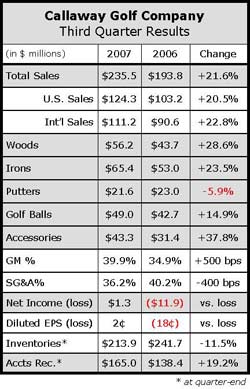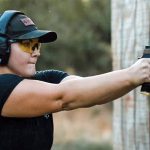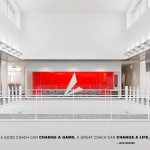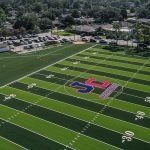Callaway Golf Company saw the third quarter produce  the strongest top-line quarterly growth the company has realized thus far in fiscal 2007, while also swinging to a net profit on the bottom line after a net loss in the year-ago quarter. While an extended season courtesy of the hot, dry autumn likely has some bearing on the results, the companys gross margin initiatives look to be paying off aiding the net income increase.
the strongest top-line quarterly growth the company has realized thus far in fiscal 2007, while also swinging to a net profit on the bottom line after a net loss in the year-ago quarter. While an extended season courtesy of the hot, dry autumn likely has some bearing on the results, the companys gross margin initiatives look to be paying off aiding the net income increase.
The weakened U.S. Dollar also helped the company, boosting sales by approximately $4.7 million for the quarter. The results led ELY to raise annual guidance for the third straight quarter.
Overall sales of golf clubs increased 23.5% to $186.5 million from $151.1 million in the year-ago quarter. Every segment in the companys clubs business posted double-digit sales gains for the quarter, except for putters, which were down in the mid-singles. The company reported on a conference call with analysts that woods share in the U.S. on a year-to-date basis was up 2.4 share points and up 3.9 share points in the U.K. In irons in the
U.S., share was up almost one share point and in the U.K. up 2.6 share points. In woods, the company attributed the strong growth to continued demand for the Fusion line, offset somewhat by a “slight decline” in fairway woods. In its 10-Q filing with the SEC, the company noted that its woods line experienced an increase in average selling prices combined with an increase in unit volume over the year-ago quarter, primarily as a result of “significant re-orders” during the quarter.
Irons and wedges grew over 20%, though slightly behind woods, on strength in the X-Series line. The aging Fusion line, which is nearing the end of its lifecycle, offset some of the growth fueled by the X-Series line. Similarly, the X-Series line expanded units sold during the quarter, but the Fusion line caused a decrease in average selling price.
The decrease in sales of putters was attributed to a decrease in units sold as the White Steel and Tri-ball models entered the end of their respective lifecycles. This decrease was partially offset by an increase in average selling prices due to new putter introductions.
Golf ball sales saw mid-teens growth as both Callaway branded balls and the Top-Flite D2 spurred growth. The company reported increased unit volume with a “slight increase” in ASP as a result of the cutback in Top-Flite SKUs leaving only higher priced TF product on the shelves. The ball business posted another operating loss for the quarter, but narrowed from a loss of $8.7 million in the year-ago to a loss of $2.8 million this year.
The strong growth in accessories was accounted for in strong footwear growth, with bags and gloves also providing a boost.
The 22% growth seen in the international markets for Callaway came as a result of sales increases in each of its regions. Sales in the EU grew 40.3% to $41.0 million from $29.2 million in the year-ago quarter with more favorable weather patterns this year helping the companys cause, but management also attributing the growth to new products being “very well received literally across the board.” Sales to
Japan grew 8.3% to $25.2 million from $23.2 million last year, while sales to the rest of Asia grew 12.4% to $20.5 million from $18.3 million in the third quarter last year. The Rest of World posted 23.7% sales growth to $24.6 million from $19.9 million last year.
The increase in gross profit as a percent of sales is primarily the result of the companys gross margin improvement initiatives announced in November 2006, aided by a product mix shift towards higher margin Fusion woods and X-series irons products.
On the bottom line, the company noted that reported diluted earnings per share include four cents of after-tax charges for the gross margin improvement initiatives, while the third quarter of 2006 included after-tax charges of one penny for the integration of Top-Flite and one penny for restructuring initiatives. Excluding these charges, pro forma diluted earnings per share for the quarter would have been six cents compared to a loss per share of 16 cents for the third quarter of 2006.
Looking ahead, the company estimates its full year 2007 net sales will be between $1.095 billion and $1.105 billion, compared to the previous estimate of $1.07 billion to $1.08 billion. Diluted earnings per share for the full year on a pro forma basis are expected to be in the range of 85 cents to 89 cents compared to the estimate provided last quarter of 78 cents to 84 cents. Pro forma earnings exclude charges related to the gross margin improvement initiatives, estimated at 8 cents per share for 2007.
>>> Global warming
Some win, same lose…














